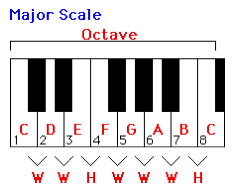| 5 |
Major Scale |
| The major scale is a specific pattern of whole steps and half steps encompassing one octave. A half step is the distance between a key on the piano keyboard and the next adjacent key with no keys in between (white or black). A whole step is the equivalent of two half steps. It skips the closest adjacent key and goes to the next one. |
|||||
|
||||||
| (W = whole step; H = half step) The major scale pattern of whole steps and half steps is the same as that found on the white notes of the piano from any C up to the next C. The whole steps will always fall between scale degrees 1 & 2, 2 & 3, 4 & 5, 5 & 6, and 6 & 7. The half steps will always fall between scale degrees 3 & 4 and 7 & 8. When a scale begins on a pitch other than C, accidentals must be used to maintain the pattern of steps. An accidental will precede the note it alters. They are as follows: |
|||||
